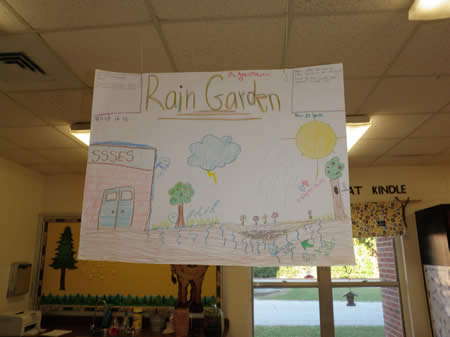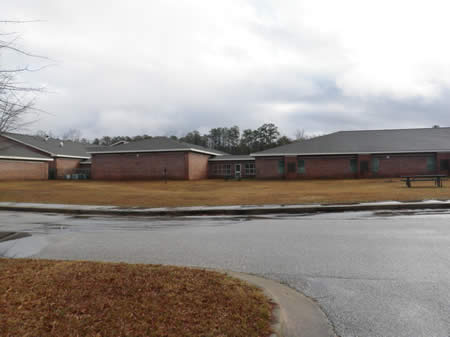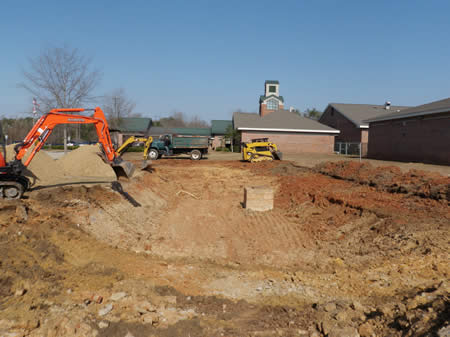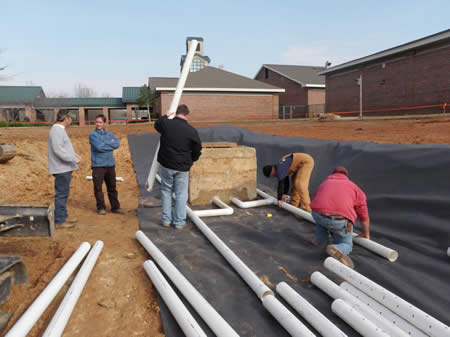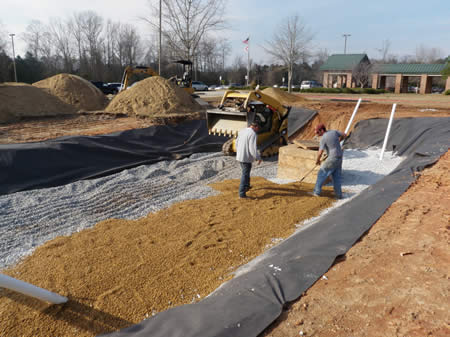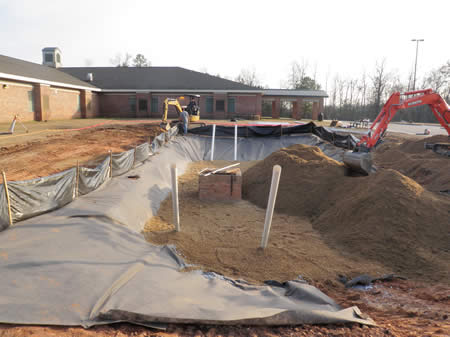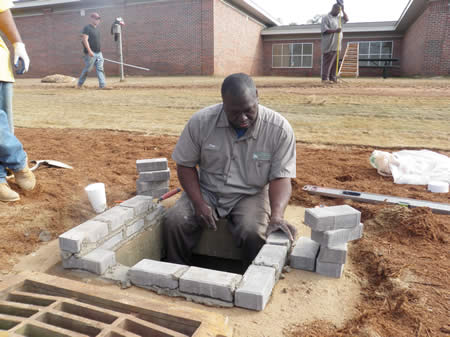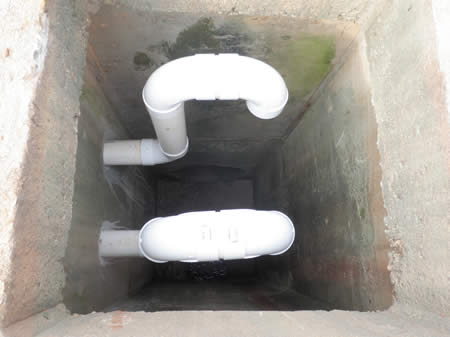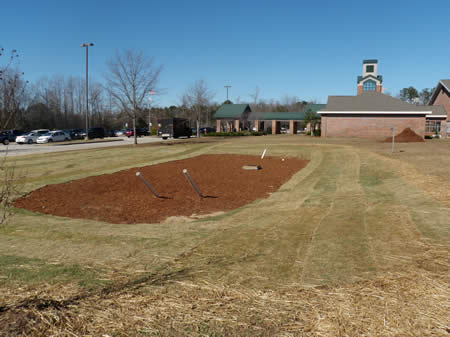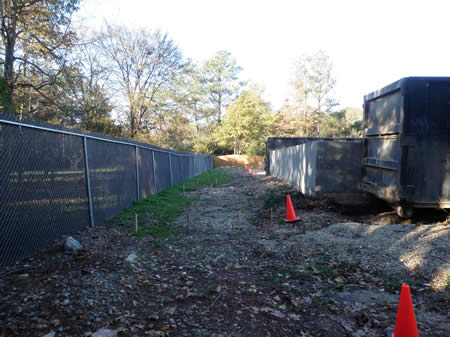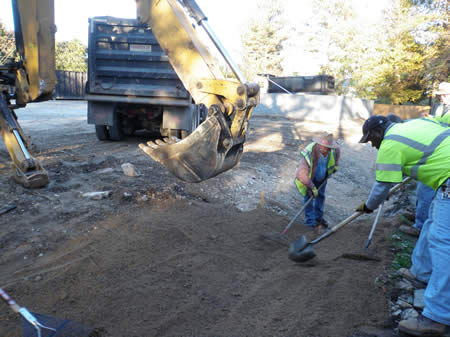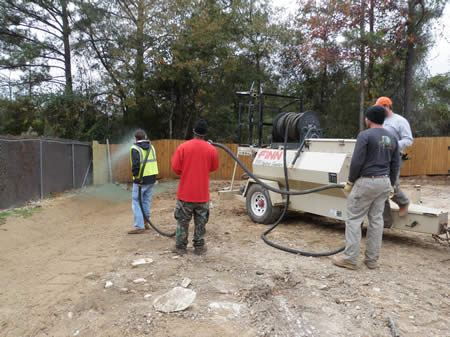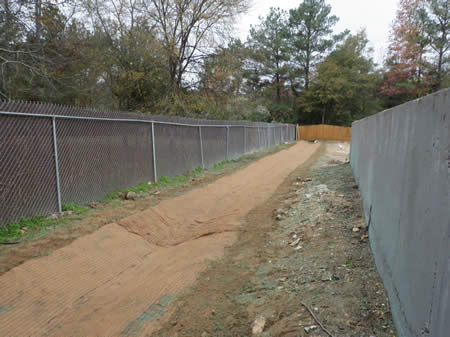
- Project Partners
- Mill Creek Watershed Plan
- Watershed Photos
- Monitoring Sites and Data
- Upcoming Activities
- Our Progress
- Holland Creek Enhancement
- Activities
- Contact
- Mill Creek Home
- Water Resources Home
Our Progress
On-the-ground best management practices (BMPs) we are implementing to improve the health and water quality of Mill Creek primarily target stormwater runoff and sediment.
What is stormwater runoff?
Stormwater runoff is rain that hits an impervious surface and picks up pollutants to carry them downstream. Impervious surfaces include rooftops, concrete, or any other material that does not allow water to soak in the ground. Think about all of the litter, tire particles, sediment, oils, grease, etc. found on parking lot surfaces. All of these materials are picked up and carried away into the nearest storm drain and eventually into the creek. Practices such as bioretention areas and rain gardens capture stormwater runoff and give it a chance to soak into the ground and filter out pollutants.
Bioretention areas capture and hold stormwater runoff to reduce pollutants through plant uptake, deposition on the mulch layer, filtration, nutrient cycling, and microbial activity to break down pollutants. Bioretention areas are sized based on the amount of land required to capture the first flush or first 1-1.5" of stormwater. The first flush contains the highest amount of pollutants.
Bioretention Area at Smiths Station East Elementary School
A bioretention area was constructed to capture rooftop runoff at a local school adjacent to Mill Creek (view map).
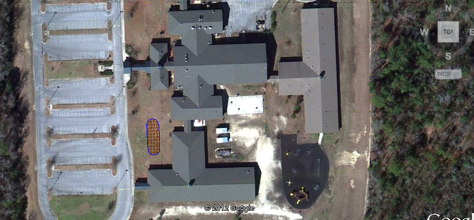
This site was chosen because of the school's proximity to Mill Creek, educational opportunities as a demonstration site to teach students, and the likelihood of improving water quality of water discharged into Mill Creek. The bioretention area slows stormwater from entering the stream to reduce peak discharges during and immediately after a heavy rain event. This site offered great equipment access and there were no underground utilities in the way of excavation.
Excavation
Our contractor, Southern Environmental Landscaping Contractors, Inc., used a tracked excavator to dig out the bottom of the bowl. A laser level was used to make sure we had the bottom of the bowl at the correct elevation. Notice the green dump truck in the background. We took excavated soil and used it to fill in eroded areas on campus.
Installing Underdrains and Backfilling with Stone and Media
Perforated PVC pipe is used to drain the bioretention area. We installed these pipes after the holes were drilled in the concrete storm drain box.
Filter fabric was installed across the bottom of the cell. We then placed a 6" layer of #57 stone and a 2" layer of peagravel. You can see the clean out pipes that are attached to the underdrains using 45 degree connectors. These clean outs can be flushed using a powerful hose to help push a clog through if the bioretention area becomes clogged.
The bioretention media is a mixture of 85-88% sand, 8-12% fines (topsoil), and 3-5% organics (shredded mulch). This quick draining media helps drain ponded water from the top of the cell down into the bottom of the bowl so that nutrient cycling and microbial breakdown can take place.
Raising the Existing Storm Drain Inlet
We used bricks to raise the existing inlet up 6". This encourages standing water so that the first flush can be captured. Any amount over the first flush will not be captured by the bioretention area and will instead go directly into the inlet.
Internal Water Storage Layer
This "s" configuration is used to create a forced, saturated anaerobic zone in the bottom of the bioretention area. This anaerobic zone fosters nutrient cycling and cleans up stormwater so that water leaving the bioretention area is cleaner than what entered it. There is approximately 2' of stormwater storage in the bottom of the cell. Head pressure pushes clean water from the underdrains into the storm drain network. Bioretention areas with this internal water storage (IWS) layer have shown higher pollutant load reductions compared to conventional bioretention areas without IWS.
Mulch, Sod, and Waiting for Plants
Bermudagrass sod was used to stabilize the 3:1 side slopes. Sod is used because it provides immediate stabilization. The clean out pipes will soon be cut and capped. We have not planted the bioretention area yet because we are working with students to create a native vegetation planting plan. In the Spring we will have a planting day with students, parents, and teachers!
Click here to see a photo album of all of the construction photos.
Erosion and Sediment Control at Smiths Station East Elementary
When we first visited this campus, several eroded areas were one of the first things we noticed. The soils on the hill sides are highly erodible and sandy in nature making for easy transport down slope and eventually into Mill Creek.
Zan Price, our engineer, had a great idea to waste soil from excavation for the bioretention area on site to repair some of the eroded areas. It ended up working out perfectly! Our contractor, Erosion Pros, LLC stabilized eroded areas by filling in cut slope areas with soil, spreading seed and fertilizer, and using an erosion control blanket to keep the soil stable until the grass begins to grow.
The channelized head cut was reshaped and Class I Rip Rap was used to hard armor the channel. Class I Rip Rap was used in the channel based on the velocity of flow that the channel receives. See photos below.
A note on fertilization: we collected samples for a soil test from the Auburn University Soil Testing Lab to determine fertilizer and lime required for plant establishment. We applied minimal fertilizer based on the soil test recommendations.
We are fortunate to work with great partners for these projects including the Lee County Board of Education and Smiths Water and Sewer Authority.
Before Photos
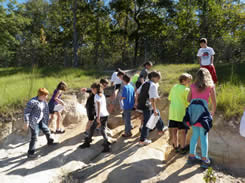 |
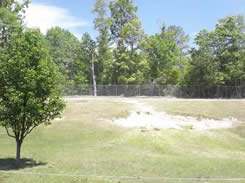 |
| Cut Slope Behind Playground | |
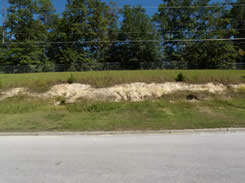 |
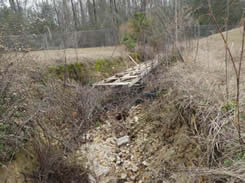 |
| Northern Cut Slope | Channelized Head Cut |
After Photos
 |
 |
| Repaired Cut Slope Behind Playground | |
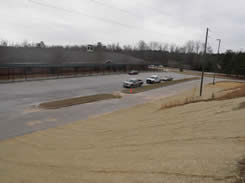 |
 |
| Repaired Northern Cut Slope | |
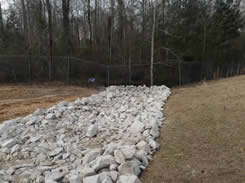 |
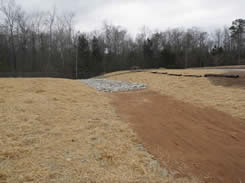 |
| Repaired Channelized Head Cut | |
Erosion and Sediment Control at Smiths Station Junior High School
The Smiths Station Junior High School is adjacent to Mill Creek headwaters, or the start of Mill Creek. Near their ROTC practice field, there was a head cut where sediment was being lost into the storm drain network. Erosion Pros, LLC repaired the head cut by reshaping the channel and placing a small amount of Class I Rip Rap to hard armor the channel. They also reshaped and stabilized the channel upslope near Smiths Station South Elementary School.
Before Photos
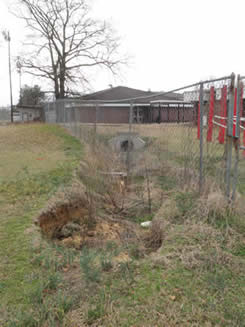 |
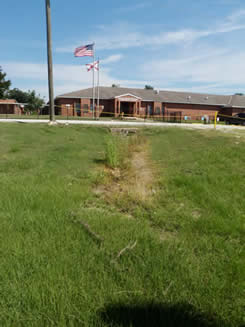 |
| Channelized Head Cut | Upslope Culvert |
After Photos
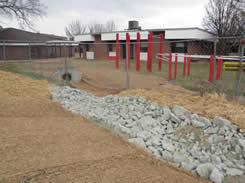 |
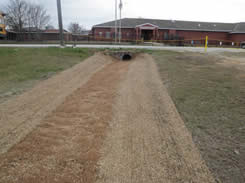 |
| Repaired Channelized Head Cut | Reshaped Channel Upslope |
Erosion and Sediment Control at Central High School in Phenix City
Central High School sits very close to a tributary to Mill Creek. Initially we considered a stormwater practice on campus to slow runoff, but after visiting the campus several times, we determined that the best water quality improvement we could make would be to address the erosion issues on campus. We were particularly concerened with a couple of heavily eroded areas that were losing sediment into the storm drain and into Mill Creek.
Before Photos
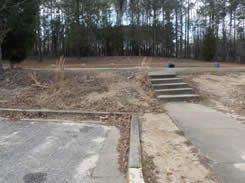 |
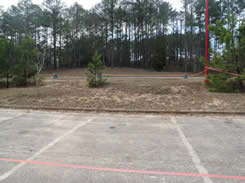 |
|
| Erosion in Parking Lot Island | ||
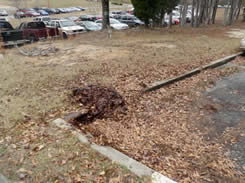 |
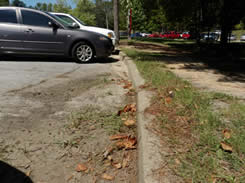 |
|
| Leaf Debris Piled at Inlet Upslope | Sediment Accumulation Downslope | |
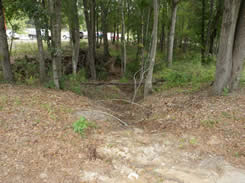 |
||
| Erosion of Ephemeral Stream Channel | ||
After Photos
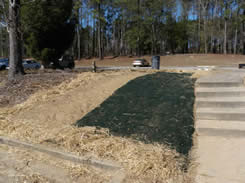 |
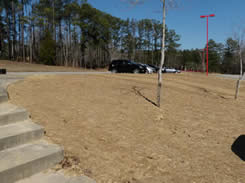 |
| Repaired Parking Lot Island | |
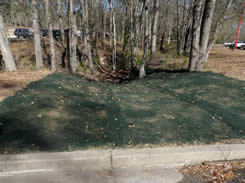 |
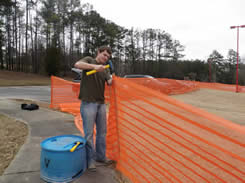 |
| Repaired Erosion at Channel | Installing Safety Fence |
Swale at Lee County Solid Waste Site on Lee Road 240 in Smiths Station
A swale was constructed on the southside of the lot to treat leachate from the solid waste bins. This site is approximately four tenths of a mile from a tributary to Mill Creek and the goal was to capture and infiltrate some of the leachate from the bins before it leaves the site.
Lee County was a HUGE partner on this project. They provided labor, materials, and equipment to excavate and construct the swale. Without Lee County's support, we could not have installed this swale!
Before Construction
The existing soil was a mixture of chert and crush and run material that was not suitable for our swale. We removed this material and used a specialized soil mix that would promote infiltration and pollutant removal.
During Construction
The swale was graded by hand with shovels and rakes under the supervision of Joey Hundley, the Special Projects Coordinator at Lee County Highway Department.
Hydroseeding the Swale
We used a hydroseeder to spray mulch, seed, and fertilizer into the channel. After hydroseeding the swale, Erosion Pros, LLC installed a coconut fiber erosion control blanket to hold the swale in place while vegetation gets established.
A coconut fiber erosion control blanket was used to stabilize the swale until grass begins to grow.
Mill Creek Trash Clean Up!
We targeted an illegal dump site located in Phenix City for the first trash clean up planned as part of the Mill Creek Project. The City of Phenix City provided Public Works labor and equipment including a truck with a grab arm to remove large items. Items removed included tires and miscellaneous trash. The City of Phenix City estimated that we removed over 50 tons of trash from the area!
Please take a moment to browse the before and after pictures!
Before
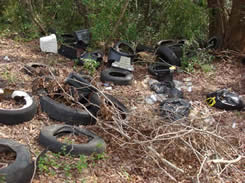 |
 |
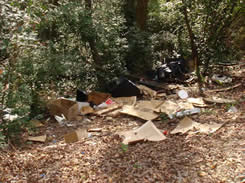 |
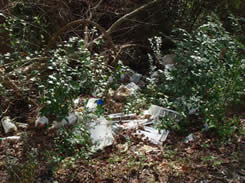 |
During
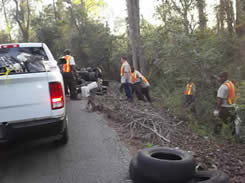 |
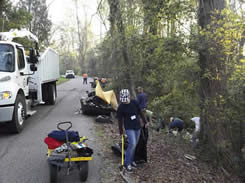 |
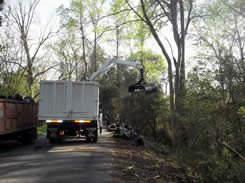 |
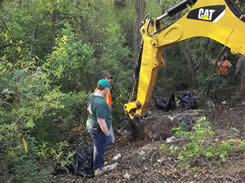 |
After
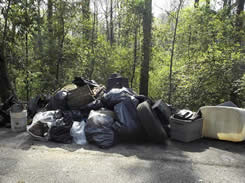 |
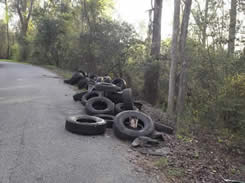 |
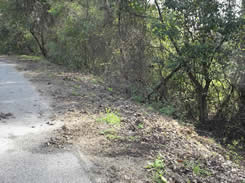 |
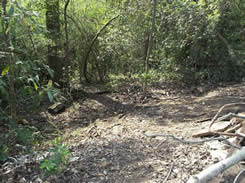 |

 Menu
Menu


